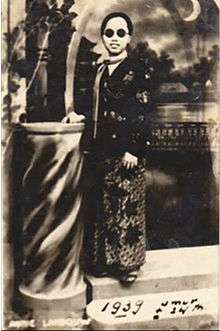Annie Landouw
Annie Landouw (also Landauw, 1913 – 17 August 1982) was an Indonesian keroncong singer and film actress.
Annie Landouw | |
|---|---|
 1939 promotional still | |
| Born | 1913 |
| Died | 17 August 1982 |
| Nationality | Indonesian |
| Other names | Annie Landauw |
| Occupation |
|
Biography
Landouw was born in Surakarta, Central Java, in 1913. She lost her sight following an extended illness as a child, and was not long afterwards adopted by her aunt and uncle. In 1927 she competed in – and won – her first singing competition, a Concours concert at a night fair in Surakarta. As a result, she was approached by Beka, a recording company, which signed her. She moved to Batavia (now Jakarta), the capital of the Dutch East Indies, soon afterwards and quickly rose in popularity.[1]
By 1938 Landouw had joined the NIROM radio troupe, singing keroncong. The following year she joined Hugo Dumas' troupe Lief Java.[1] During this period she became active in film. In 1938 she provided vocals for Fatima, a production by Tan's Film;[2] she provided vocals again for Tan's 1939 film Gagak Item (Black Raven).[3] She made her onscreen debut later that year, with Siti Akbari. In 1940 she appeared in two further films, Sorga Ka Toedjoe (Seventh Heaven) and Roekihati.[4]
Landouw's prowess singing keroncong rendered her immensely popular. In 1940, the blind singer was scheduled for eye surgery.[5] Her fans organised a fundraising campaign to help her pay for it, although ultimately Landouw refused the charity.[5]
After Indonesia's independence, Landouw continued singing; however, she acted in no further films.[1] She died on 17 August 1982.[1]
Legacy
Music scholar Peter Keppy suggests that, because of her popularity as a keroncong singer, Landouw may have influenced the character of Yah in Armijn Pane's 1940 novel Belenggu;[6] in the novel, Yah is famous as a keroncong singer under the stage name Siti Hayati.[7]
References
Works cited
- Apa Siapa Orang Film Indonesia [What and Who: Film Figures in Indonesia] (in Indonesian). Jakarta: Indonesian Ministry of Information. 1999. OCLC 44427179.
- "Annie Landouw". filmindonesia.or.id (in Indonesian). Jakarta: Konfiden Foundation. Archived from the original on 11 June 2013. Retrieved 11 June 2013.
- "Fatima". filmindonesia.or.id (in Indonesian). Jakarta: Konfidan Foundation. Archived from the original on 24 July 2012. Retrieved 24 July 2012.
- "Gagak Item". Bataviaasch Nieuwsblad (in Dutch). Batavia: Kolff & Co. 19 December 1939. p. 3. Retrieved 4 March 2013.
- Keppy, Peter (2008). "Keroncong, Concours, and Crooners: Home-grown Entertainment in Early Twentieth-century Batavia". In Boomgaard, P.; Kooiman, Dick; Nordholt, Henk Schulte (eds.). Linking Destinies: Trade, Towns and Kin in Asian History. Verhandelingen van het Koninklijk Instituut voor Taal-, Land- en Volkenkunde. 256. pp. 141–58. ISBN 978-90-6718-320-8.CS1 maint: ref=harv (link)
- Mohamad, Goenawan (20 April 1985). "Yah". Tempo (in Indonesian). Archived from the original on 3 February 2012. Retrieved 3 February 2012.